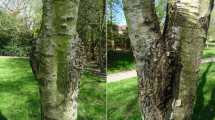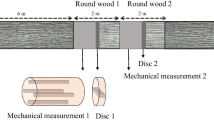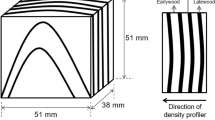Abstract
Key message
This study provides data necessary to develop mechanistic models of the failure of open-grown trees. The literature contains few such data. Some results contrast previous studies on conifers.
Abstract
In cities and towns, tree failure can cause damage and injury. Few studies have considered large, open-grown trees when measuring parameters related to tree failure. To measure elastic modulus and maximum bending moment and stress, we winched red oaks (Quercus rubra L.), including some with co-dominant stems and others with extant decay. To simulate decay in a subsample of trees, we cut voids in the trunk before pulling trees to failure. Maximum bending moment was greatest for uprooted trees, but maximum bending and shear stresses were greatest for trees that failed in the crown in the vicinity of branches. The likelihood of failure at a void or area of extant decay increased as the loss in area moment of inertia increased. The moduli of elasticity and rupture of specimens taken from trees were greater than values measured on the trees themselves. Failure at the union of co-dominant stems only occurred when we pulled them apart, loading them perpendicular to the plane bifurcating the union. Some of the results are inconsistent with previous work on conifers; more data on open-grown trees are necessary to develop mechanistic models to predict tree failure.






Similar content being viewed by others
References
Achim A, Ruel J, Gardiner B, Laflamme G, Meunier S (2005) Modelling the vulnerability of balsam fir forests to wind damage. For Ecol Manage 204:37–52
ASTM (2014) Standard test methods for small clear specimens of timber D-143-09 (2014). ASTM International, West Conshohocken
Bergeron C, Ruel J, Élie J, Mitchell S (2009) Root anchorage and stem strength of black spruce (Picea mariana) trees in regular and irregular stands. Forestry 82:29–41
Brudi E, van Wassanaer P (2001) Trees and statics: nondestructive failure analysis. In: Smiley ET, Coder K (eds) Tree structure and mechanics conference proceedings: how trees stand up and fall down. International Society of Arboriculture Champaign, IL, pp 53–69
Ciftci C, Brena S, Kane B, Arwade S (2013) Effects of crown architecture on dynamic behavior of decurrent trees: understanding the relationship between branches and stem. Trees 27:1175–1189
Ciftci C, Kane B, Brena SF, Arwade SR (2014) Loss in moment capacity of tree stems induced by decay. Trees 28:517–529
Coder KD (1989) Should you or shouldn’t you fill tree hollows? Grounds Maint 24:68–70
Fredericksen TS, Williams RL, Hedden SA (1993) Testing loblolly pine wind firmness with simulated wind stress. Can J For Res 23:1760–1765
Gardiner B, Byrne K, Hale S, Kamimura K, Mitchell SJ, Peltola H, Ruel J (2008) A review of mechanistic modelling of wind damage risk to forests. Forestry 81:447–463
Gilman EF (2003) Branch-to-stem diameter ratio affects strength of attachment. J Arboric 29:291
Glass SV, Zelinka SL (2010) Moisture relations and physical properties of wood, In: Wood handbook, wood as an engineering material (Chapter 4) Department of Agriculture, Forest Service, Forest Products Laboratory, Madison
Greig BJW, Gibbs NJ (1990) Survey of parkland trees and the great storm of October 16, 1987. Arboric J 14:321
James KR, Kane B (2008) Precision digital instruments to measure dynamic wind loads on trees during storms. Agric For Meteorol 148:1055–1061
Kane B (2008) Tree failure following a windstorm in Brewster, Massachusetts, USA. Urb For Urb Green 7:15–23
Kane B, Clouston PL (2008) Tree pulling tests of large shade trees in the genus Acer. Arboric Urb For 34:101–109
Kane B, James KR (2011) Dynamic properties of open-grown deciduous trees. Can J For Res 41:321–330
Kane B, Ryan D (2004) The accuracy of formulas used to assess strength loss due to decay in trees. J Arboric 30:347–356
Kane B, Farrell R, Zedaker SM, Loferski JR, Smith DW (2008) Failure mode and prediction of the strength of branch attachments. Arboric Urb For 34:308–316
Kane B, Modarres-Sadeghi Y, James KR, Reiland M (2014) Effects of crown structure on the sway characteristics of large decurrent trees. Trees 28:151–159
Kretschmann DE (2010) Mechanical properties of wood, In: Wood handbook, wood as an engineering material (Chapter 5) Department of Agriculture, Forest Service, Forest Products Laboratory, Madison, WI
Lilly S, Sydnor TD (1995) Comparison of branch failure during static loading of silver and Norway maples. J Arboric 21:302–305
Mattheck C, Bethge K, Schafer J (1993) Safety factors in trees. J Theor Biol 165:185–189
Moore JR (2000) Differences in maximum resistive bending moments of Pinus radiata trees grown on a range of soil types. For Ecol Manage 135:63–71
Mortimer MJ, Kane B (2004) Hazard tree liability in the United States: uncertain risks for owners and professionals. Urb For Urb Green 2:159–165
Nicoll BC, Gardiner BA, Rayner B, Peace AJ (2006) Anchorage of coniferous trees in relation to species, soil type, and rooting depth. Can J For Res 36:1871–1883
Niklas KJ (1997) Size- and age-dependent variation in the properties of sap- and heartwood in black locust (Robinia pseudoacacia L.). Ann Bot 79:473–478
Nowak DJ, Dwyer JF (2000) Understanding the benefits and costs of urban forest ecosystems. In: Kuser JE (ed) Handbook of urban and community forestry in the northeast. Plenum Publishers, NY, pp 11–25
Nowak DJ, Stevens JC, Sisinni SM, Luley CJ (2002) Effects of urban tree management and species selection on atmospheric carbon dioxide. J Arboric 28:113–122
Okuyama T, Yamamoto H, Yoshida M, Hattori Y, Archer R (1994) Growth stresses in tension wood: role of microfibrils and lignification. Ann For Sci 51(3):291–300
Papesch AJG, Moore JR, Hawke AE (1997) Stability of Pinus radiata trees at Eyrewell Forest investigated using static tests. New Zealand J For Sci 27:188–204
Peltola HM (2006) Mechanical stability of trees under static loads. Am J Bot 93:1501–1511
Peltola H, Kellomaki S, Hassinen A, Granander M (2000) Mechanical stability of Scots pine, Norway spruce and birch: an analysis of tree-pulling experiments in Finland. For Ecol Manage 135:143–153
Peterson CJ, Claassen V (2013) An evaluation of the stability of Quercus lobata and Populus fremontii on river levees assessed using static winching tests. Forestry 86:201–209
Ruel J-C, Achim A, Herrera R, Cloutier A (2010) Relating mechanical strength at the stem level to values obtained from defect-free wood samples. Trees 24:1127–1135
Schmidlin TW (2009) Human fatalities from wind-related tree failures in the United States, 1995–2007. Nat Hazards 50:13–25
Slater D, Ennos AR (2013) Determining the mechanical properties of hazel forks by testing their component parts. Trees 27:1515–1524
Smiley ET (2003) Does included bark reduce the strength of codominant stems? J Arboric 29:104–106
Smiley ET, Fraedrich BR (1992) Determining strength loss from decay. J Arboric 18:201–204
Wagener WW (1963) Judging hazard from native trees in California recreational areas: a guide for professional foresters. USFS research paper PSW-P1, 29 p. pacific southwest forest and range experiment station, forest service, US Dept. of Agriculture, Berkeley, Calif
Wilhelmy V, Kubler H (1973) Stresses and checks in log ends from relieved growth stresses. Wood Sci 6:136–142
Yao J (1979) Relationships between height and growth stresses within and among white ash, water oak, and Shagbark hickory. Wood Sci 11:246–251
Author contribution statement
B. Kane conducted the experiment, analyzed the results, and wrote the manuscript.
Acknowledgments
The TREE Fund’s Dr. Mark S. McClure Fellowship in Tree Biomechanics partially funded this study. The author gratefully acknowledges the following individuals who helped collect data: Dan Pepin, Alex Julius, Alex Sherman, Joseph Scharf, Nevin Gomez, and Sherry Hu (University of Massachusetts-Amherst), and Dr. Cihan Ciftci (Abdullah Gul Uinversity, Turkey) for calculating area moments of inertia. The author also thanks Professor Jean-Claude Ruel (Université Laval), two anonymous reviewers, and the Communicating Editor for critically reviewing previous drafts.
Conflict of interest
None declared.
Author information
Authors and Affiliations
Corresponding author
Additional information
Communicated by T. Fourcaud.
Appendix A
Appendix A
In standing trees, the effect of axial growth stress is additive to axial and wind-induced bending stresses. Axial stress due to self-weight is uniformly compressive throughout the cross section. Bending stresses are tensile and compressive, and their magnitude is greatest at the circumference of the cross section. Growth stresses are compressive near the pith and maximally tensile at the circumference of the cross section. During the winching tests, tensile growth stress at the circumference of the cross section counteracts the combined compressive axial and bending stress due to self-weight and the test itself. We used two methods to estimate the combined effect of axial compressive stress due to self-weight and tensile growth stress and compared it to the total compressive stress (axial and bending) induced by winching.
In the first method, we gleaned values of axial tensile growth stress from the literature. On stems of oaks growing without a lean, the magnitude of axial tensile growth stress was about 6 MPa (Wilhelmy and Kubler 1973; Yao 1979), similar to the value reported for the compression side of a leaning red oak (Okuyama et al. 1994). Since none of the measured red oaks expressed a lean, we assumed the value of 6 MPa. Next, we estimated axial compressive stress due to self-weight from (1) the volume of the stem above the height at which we sawed the void, (2) the density of the wood measured from green specimens sampled from the tree, and (3) the cross-sectional area of the stem excluding the sawn void. For each tree, we subtracted axial compressive stress due to self-weight from tensile growth stress of 6 MPa.
In the second method, we calculated the difference between baseline axial displacements (i.e., before applying the load, but after branches were pruned) before and after we cut voids into the trees. For each tree, we converted the difference to a strain and multiplied by the elastic modulus of green specimens sampled from the tree and tested in 3-point bending (ASTM 2014). This estimated the combined effect of axial compressive stress due to self-weight and axial tensile growth stress after notching. For either method and all trees, the maximum ratio of (1) the combined effect of axial compressive stress due to self-weight and tensile growth stress to (2) the total compressive stress (axial and bending) induced while winching the tree to failure was 0.002.
Rights and permissions
About this article
Cite this article
Kane, B. Determining parameters related to the likelihood of failure of red oak (Quercus rubra L.) from winching tests. Trees 28, 1667–1677 (2014). https://doi.org/10.1007/s00468-014-1076-0
Received:
Revised:
Accepted:
Published:
Issue Date:
DOI: https://doi.org/10.1007/s00468-014-1076-0




